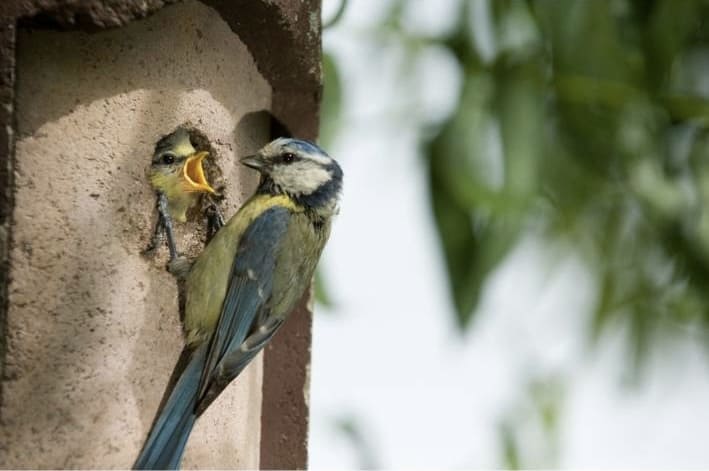Blue tits are fascinating garden birds. Their vibrant personality (and colour!) makes them an interesting group of garden tits to study and observe. So, how many blue tit eggs will a pair of blue tits have and care for in their lifetime, and how many of these will make it to adulthood?
Blue tits usually have two broods a year, and typically live for three years. This means that in their lifetime, a blue tit will have between two and six broods. These birds lay between 7 and 13 blue tit eggs per brood, and will have two broods per year. This means that over the course of her lifetime, a female blue tit can lay up to 78 eggs! However, not all of these will make it to adulthood. A study carried out in the UK revealed that only 38% of baby blue tits will make it to one year old, or approximately 30 of a female’s 78 eggs. Once they have reached adulthood, the annual survival rate of a blue tit is approximately 50%, which isn’t hugely different from other garden tits.
Blue tits (scientific name Cyanistes caeruleus) are the only type of tit with a blue wing, a blue tail and a blue crown, surrounded by a white border. They have yellow chests and white cheeks, and a black stripe that outlines the eye and cheeks.
Their back is yellow-green in colour, and they have a black-brown bill. Interestingly, the yellowness of the chest of a blue tit is a result of high levels of carotene pigments in the diet, gained mainly from eating yellow caterpillars.
Male and female blue tits look very similar, but the colours on females are slightly less bright. Juvenile blue tits are more green-brown than blue, and their cheeks are yellow. Blue tits average 12cm in length, with a wingspan of 18cm. They typically weigh 11g, and are similar in size to other types of tits. Male and female blue tits are similar in size.
Blue tits, like many other garden tits, breed from April until late June-early July. They are monogamous, meaning one male will mate with one female per breeding season. They mate for life, and are loyal birds. Their loyalty means that they are fiercely protective of their blue tit eggs, hissing at and biting intruders in their nest, earning them the colloquial nickname “Billy Biter” in the UK.
If one blue tit in a pair dies, the other will attempt to find a new mate. A recent report from the Royal Society for the Protection of Birds (RSPB) found there to be over 3.5 million breeding pairs of blue tits in the UK.
Female blue tits build their nests in spring, in preparation for the arrival of their young. They typically nest in small nooks and crannies such as holes in tree trunks or in hedge rows. They have been known not to be fussy with their nesting places, and have even been founding nesting in peculiar places such as post boxes. They are big fans of artificial nest boxes, and appreciate the security and safety they provide from predators.
Blue tit eggs are laid in a nest that is a cup-shaped structure, usually made from a mixture of foraged dried grass, tree bark, dead leaves, moss and spiders’ webs. Blue tits will happily use the same nesting site each year that they breed, and when one pair dies, another will occupy the space.
Blue tit eggs are smooth and glossy. They’re mainly white, but will have reddish-purple or brown spots. The female blue tit incubates her eggs for approximately two weeks before they hatch. During this time, her male partner will bring her food. Once hatched, nestling blue tits are fed a diet of caterpillars, and are fully dependent on their parents for up to 22 days after hatching. Once they are large enough and strong enough, fledgling blue tits will fly the nest.
So, there you have it! Here’s how to identify a blue tit in your garden, and how and when local blue tits will breed. Read more about the life cycle of a blue tit here, and when blue tits tend to begin nesting here. If you’re interested in other birds, check out our articles on robins and dunnocks!

